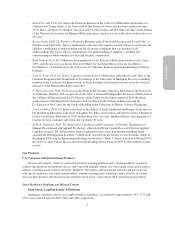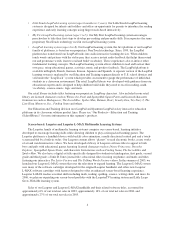LeapFrog 2005 Annual Report Download - page 19
Download and view the complete annual report
Please find page 19 of the 2005 LeapFrog annual report below. You can navigate through the pages in the report by either clicking on the pages listed below, or by using the keyword search tool below to find specific information within the annual report.videos on both the handheld’s screen and a television screen. The platform leverages our Leapster software
library and our educational titles using licensed and non-licensed content. VTech is a competitor in the screen-
based category with their V.Smile and V.Smile Pocket game platforms. The V.Smile Pocket is a portable,
handheld educational gaming platform that competes directly with our Leapster handheld while the V.Smile is a
game console competing with our Leapster L-MAX system. VTech, a Hong Kong- based electronics company, is
larger and more diversified than LeapFrog. As a result, we believe that VTech may have an advantage with
respect to sourcing products and components that may enable them to provide a more rapid competitive response
to the market. In addition, we believe that our Leapster family competes with other popular handheld and console
game platforms with less educational focus, such as Nintendo Co., Ltd., Sony Corporation’s PlayStation and
PlayStation Portable and Jakks Pacific’s Plug-And-Play Controller.
With the introduction of our FLY Pentop Computer, we have entered a new competitive arena. The FLY
Pentop Computer is targeted at market for ages eight years and older. This is an age group that no longer
considers themselves children as they become more image conscious and often emulate older siblings. Our FLY
marketing plan has allowed us to begin to merchandise our products away from the toy aisle and other LeapFrog
branded products. The FLY Pentop Computer and associated products can be found at retail with other electronic
products, and may therefore compete with other electronic devices marketed at tweens including cellular phones
and MP3 music devices. We believe that producers of smart mobile devices, such as personal digital assistants,
non-mobile game platforms and computer-based software may be able to compete effectively in our primary
markets by developing engaging educational products that run on their platforms. Many of these companies have
significantly larger installed bases than we do. In addition, a number of major hardware and software makers
have developed pen-based portable computers like the Tablet PC that could compete with our new FLY Pentop
Computer . Consequently, competitors may include companies like Apple Computer, Inc., Fujitsu Limited,
Hewlett-Packard Company, Microsoft Corporation, Palm, Inc., Sega Corporation and Toshiba.
Our SchoolHouse division competes in the U.S. supplemental educational materials market. We believe the
principal competitive factors affecting the market for our products in the school market are proven educational
effectiveness, brand, features and price. Our SchoolHouse division faces competition in the supplemental
curriculum market from major textbook publishers such as Harcourt (a division of Reed Elsevier), Houghton
Mifflin Company, McGraw-Hill, Pearson plc and Scholastic Corporation, as well as electronic educational
material and service providers such as Knowledge Adventure, Compass Learning, PLATO Learning, Inc.,
Renaissance Learning and Riverdeep Group plc. In the future, large entertainment companies such as Viacom
International, Inc. and Walt Disney Co. may begin to target the school markets.
For a discussion of the possible effects that competition could have on our business, see “Item 1A—Risk
Factors—If we are unable to compete effectively with existing or new competitors, our sales and market share
could decline.”
Seasonality
LeapFrog’s business is highly seasonal, with our retail customers making a large percentage of all purchases
during the back-to-school and traditional holiday seasons. Our business, being subject to these significant
seasonal fluctuations, generally realizes the majority of our net sales and all of our net income during the third
and fourth calendar quarters. These seasonal purchasing patterns and production lead times cause risk to our
business associated with the under production of popular items and over production of items that do not match
consumer demand. In addition, we have seen our customers managing their inventories more stringently,
requiring us to ship products closer to the time they expect to sell to consumers, increasing our risk to meet the
demand for specific products at peak demand times, or adversely impacting our own inventory levels by the need
to pre-build products to meet the demand.
For more information, see “Item 7—Management’s Discussion and Analysis of Financial Condition and
Result of Operations—Seasonality and Quarterly Results of Operations” and “Item 1A—Risk Factors—Our
12
























